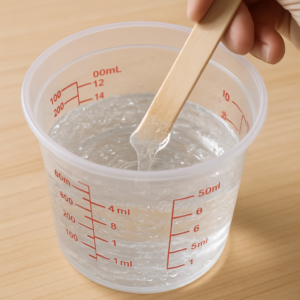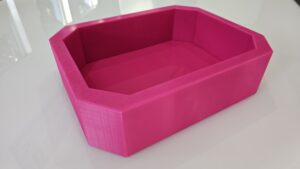Introduction
Hey there, creative crafters! Whether you’re preserving beautiful flowers or crafting your next masterpiece, choosing the right mold material can make or break your project. Today, we’re diving into the captivating world of casting by exploring the differences between silicone molds and HDPE (High-Density Polyethylene) resin molds. Each of these materials has its own special features and advantages. In this blog, we’ll help you understand which one might be the perfect fit for your casting needs. Let’s get started!
Key Characteristics of HDPE Resin Molds

HDPE resin molds present a different set of characteristics that make them just as worthwhile for various casting needs. Perfect for those who prioritize durability and efficiency, HDPE molds have their unique place in the casting world. Let’s explore their defining traits:
Material Strength and Rigidity
HDPE, or high-density polyethylene, is celebrated for its strength and rigidity. Unlike the soft nature of silicone, HDPE molds are tough and durable, able to withstand substantial pressure during the casting process. This makes them especially suitable for larger, bulkier casts where support and stability during the cure are crucial. The strength of HDPE means you won’t accidentally warp your mold or end up with a misshapen piece, making it a top choice for applications requiring robust molds that can handle repeated use.
Reusability and Cost-effectiveness
Let’s talk money and practicality—HDPE molds shine when it comes to reusability and being cost-effective. If you’re someone who plans on producing a high volume of items, the initial investment in an HDPE mold might turn out to be extremely economical in the long run. These molds are known for their impressive lifespan, retaining their shape and performing consistently well over many cycles. This capacity for endurance ultimately saves you money on replacements and allows for a more sustainable approach to your casting hobby or business.
Ease of Release and Maintenance
Another area where HDPE resin molds excel is in the ease of release. The nature of HDPE means that once your piece has set, it doesn’t take much effort to release it from its mold. The smooth surfaces of HDPE molds ensure an easy demolding process while also helping keep the final product intact without damage. Furthermore, maintaining an HDPE mold doesn’t require much hassle—just a little cleaning to keep them in tip-top shape. This ease of use makes HDPE an attractive material for both newcomers to casting and seasoned veterans looking to streamline their process.
In conclusion, both silicone and HDPE resin molds bring valuable features to the casting table, catering to different needs and preferences. Silicone molds are perfect for projects where flexibility, detail, and temperature resistance are key, while HDPE molds offer unmatched strength, cost-effectiveness, and long-term usability. Understanding these differences allows you to choose the right tool for your unique casting needs, ensuring your projects are as successful as possible. So whether you’re creating something for show or for everyday use, these molds have got you covered.
Key Characteristics of Silicone Molds

Silicone molds, particularly platinum-cured silicone molds, have become a popular choice for casting enthusiasts. Whether you’re preserving a delicate floral arrangement or getting into the nitty-gritty of casting, these molds bring certain benefits that make them a favorite in the hobbyist and professional arena alike. Let’s dive into their main characteristics:
Flexibility and Durability
One of the most appealing features of silicone molds is their incredible flexibility. The nature of silicone allows it to flex without tearing, which means you can demold even the most intricate designs without worrying about damaging your piece. This inherent flexibility is complemented by impressive durability. Silicone molds are known for withstanding repeated use over time, maintaining their shape and integrity with each casting process. That means more projects and less time spent worrying about mold replacements.
Temperature Resistance
Temperature resistance is another stellar characteristic of silicone molds. These molds can endure a wide range of temperatures without losing form, which is crucial for many casting materials that require precise conditions to set. Whether you’re working with high-heat applications or need to toss your mold into a cooling environment, silicone molds can handle the heat (or cold) without breaking a sweat. This resistance ensures that your casting process remains consistent and predictable.
Surface Finish and Detail
When it comes to capturing detail and ensuring a smooth surface finish, silicone molds have few competitors. Their smooth, non-stick surface is perfect for capturing even the minutest details of your model, resulting in a cleaner, more professional-looking cast. The mold’s ability to produce casts with intricate detail makes it particularly useful for artistic projects or any applications where precision is paramount. With silicone, you don’t have to worry about any unsightly release marks or imperfections marring your final product.
Applications in Floral Preservation
Floral preservation is a beautiful way to capture nature’s fleeting beauty in a more permanent form. Whether it’s a bouquet from a wedding or a birthday flower arrangement, casting flowers in molds can turn memories into timeless art pieces. But when it comes to preserving these delicate blooms, the choice of mold material can greatly impact the outcome.
Detail Preservation and Mold Shape
When considering the preservation of intricate floral details, the type of mold you use plays a significant role. Platinum Cured Silicone Molds are known for their incredible flexibility and ability to capture every petal’s fine detail. Their flexibility means they can hug the curves of a flower more closely, resulting in a cast that doesn’t miss a beat when it comes to texture and complexity.
In comparison, HDPE Resin Molds are sturdier and more rigid. This can make them less adept at capturing minute details. However, they are often preferred when you need a mold that maintains its shape consistently without any warping. So, if you’re working with simpler designs that require strong outlines, HDPE molds might be the way to go.
Environmental Considerations
In today’s world, environmental considerations are becoming increasingly important. When making a choice between silicone and HDPE molds, it’s worth thinking about the environmental impact of each.
– Silicone Molds: Silicone is relatively inert and does break down over time, but it is not biodegradable. They are, however, reusable, and high-quality silicone molds can last for years if cared for properly, reducing waste over time since you won’t need to constantly replace them.
– HDPE Molds: HDPE, or High-Density Polyethylene, is both recyclable and widely recycled. This means that at the end of its useful life, an HDPE mold could potentially be recycled and repurposed into new products. However, recycling options may vary depending on your local facilities.
Understanding these environmental differences can help guide you towards a mold choice that aligns with your personal priorities and values while minimizing ecological impact.
Final Presentation and Aesthetic Appeal
Finally, let’s talk about the overall presentation and aesthetic appeal of your finished floral piece. Since silicone molds allow for finer detail, they tend to yield casts with a smoother and more polished appearance right out of the mold. This can reduce the need for additional finishing work, saving you time and effort.
HDPE molds, on the other hand, form rigid and well-defined shapes, often creating a bold and structured look. This can be particularly desirable if you’re aiming for artistic pieces with a strong geometric influence or if you prefer sharper lines in your artwork.
Ultimately, the aesthetics you want to achieve can guide your mold selection. Whether you aim for elegance and delicacy with silicone or the striking precision of HDPE, understanding the capabilities of each mold will help bring your floral casting vision to life.
Deciding between silicone and HDPE resin molds requires weighing the pros and cons in the context of your specific project needs and personal preferences. By understanding how each performs in detail preservation, environmental considerations, and aesthetic appeal, you’ll be well-prepared to make the ideal choice for your floral preservation project.
Conclusion
When it comes to choosing between silicone molds and HDPE resin molds for casting, it’s crucial to understand your project’s specific needs. Silicone molds, particularly platinum-cured ones, offer flexibility and intricate detail, making them ideal for complex designs and delicate projects like floral preservation. On the other hand, HDPE resin molds are durable and cost-effective, perfect for larger or heavy-duty casts.
Ultimately, the decision comes down to weighing the balance between flexibility and durability. Whether you’re capturing the beauty of a blossom or crafting larger functional pieces, knowing your materials will ensure your final product shines. Happy casting!
The Differences Between Silicone Molds and HDPE Resin Molds for Casting
Compare silicone and HDPE resin molds for casting needs.
Curious about which mold suits your casting needs best? 🌸 Dive into our latest blog to discover the key differences between Silicone Molds and HDPE Resin Molds. Perfect for floral preservation enthusiasts and woodworking aficionados alike! 🎨✨ Get informed and make the right choice for your next project. Explore more on our website! #MoldDifferences #Casting #HDPEResinMolds #FloralPreservation #CraftYourWay

